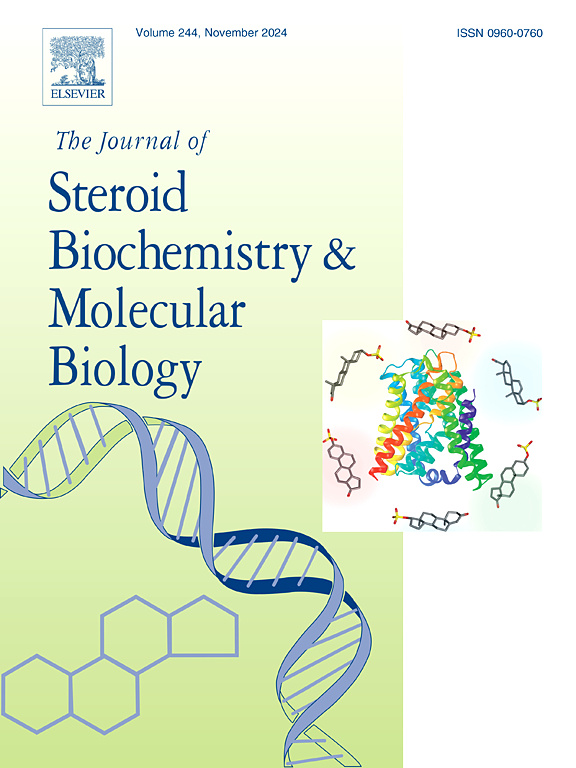Treatment response variations to a single large bolus of enteral cholecalciferol in vitamin D deficient critically Ill children: Metabolomic insights for precision nutrition
IF 2.7
2区 生物学
Q3 BIOCHEMISTRY & MOLECULAR BIOLOGY
Journal of Steroid Biochemistry and Molecular Biology
Pub Date : 2025-03-09
DOI:10.1016/j.jsbmb.2025.106720
引用次数: 0
Abstract
Vitamin D deficiency (VDD) is prevalent globally and in pediatric intensive care units, where it represents a modifiable risk factor that may impact patient recovery during hospitalization. Herein, we performed a retrospective analysis of serum samples from a phase-II randomized placebo-controlled trial involving a single large bolus of 10,000 IU/kg vitamin D3 ingested by critically ill children with VDD (25-OH-D < 50 nmol/L). Targeted and untargeted methods were used to comprehensively measure 6 vitamin D metabolites, 239 lipids, 68 polar metabolites, and 4 electrolytes using a multi-step data workflow for compound authentication. Complementary statistical methods classified circulating metabolites/lipids associated with vitamin D repletion following high-dose vitamin D3 intake (n = 20) versus placebo (n = 11) comprising an optional standard of care maintenance dose (< 1000 IU/day). There was a striking increase in median serum concentrations of 25-OH-D3 (4.7-fold), 3-epi-25-OH-D3 (24-fold) and their C3-epimer ratio (6.7-fold) in treated patients on day 3, whereas serum vitamin D3 peaked on day 1 (128-fold) unlike placebo. Treatment response differences were attributed to D3 bioavailability and C3-epimerase activity without evidence of hypercalcemia. For the first time, we report the detection of circulating 3-epi-D3 that was strongly correlated with vitamin D3 uptake (r = 0.898). Metabolomic studies revealed that vitamin D sufficiency (serum 25-OH-D >75 nmol/L) coincided with lower circulating levels of 3-methylhistidine, cystine, S-methylcysteine, uric acid, and two lysophosphatidylcholines 7 days after treatment. Rapid correction of VDD was associated with indicators of lower oxidative stress, inflammation, and muscle protein turn-over that may contribute clinical benefits in high-risk critically ill children.
维生素D缺乏的危重儿童单次大剂量肠内胆骨化醇的治疗反应变化:精确营养的代谢组学见解。
维生素D缺乏症(VDD)在全球和儿科重症监护病房普遍存在,它是一种可改变的风险因素,可能影响患者住院期间的康复。在此,我们对一项ii期随机安慰剂对照试验的血清样本进行了回顾性分析,该试验涉及VDD (25-OH-D < 50 nmol/L)危重儿童单次大剂量摄入10,000 IU/kg维生素D3。采用靶向和非靶向方法综合测量6种维生素D代谢物、239种脂质、68种极性代谢物和4种电解质,采用多步骤数据工作流进行化合物鉴定。补充统计学方法对高剂量维生素D3摄入(n=20)与安慰剂(n=11)后与维生素D补充相关的循环代谢物/脂质进行分类,包括标准护理维持剂量(< 1000 IU/天)。与安慰剂不同,治疗后第3天,25-OH-D3(4.7倍)、3-epi-25-OH-D3(24倍)及其C3-epimer比值(6.7倍)的血清中位浓度显著增加,而血清维生素D3在第1天达到峰值(128倍)。治疗反应差异归因于D3生物利用度和c3 - epimase活性,没有高钙血症的证据。我们首次报道了循环3-epi-D3的检测与维生素D3摄取密切相关(r = 0.898)。代谢组学研究显示,治疗后7天,维生素D充足(血清25-OH-D bbb75 nmol/L)与3-甲基组氨酸、胱氨酸、s -甲基半胱氨酸、尿酸和两种溶血磷脂酰胆碱的循环水平降低一致。快速纠正VDD与较低的氧化应激、炎症和肌肉蛋白周转指标相关,这可能对高危危重患儿有临床益处。
本文章由计算机程序翻译,如有差异,请以英文原文为准。
求助全文
约1分钟内获得全文
求助全文
来源期刊
CiteScore
8.60
自引率
2.40%
发文量
113
审稿时长
46 days
期刊介绍:
The Journal of Steroid Biochemistry and Molecular Biology is devoted to new experimental and theoretical developments in areas related to steroids including vitamin D, lipids and their metabolomics. The Journal publishes a variety of contributions, including original articles, general and focused reviews, and rapid communications (brief articles of particular interest and clear novelty). Selected cutting-edge topics will be addressed in Special Issues managed by Guest Editors. Special Issues will contain both commissioned reviews and original research papers to provide comprehensive coverage of specific topics, and all submissions will undergo rigorous peer-review prior to publication.

 求助内容:
求助内容: 应助结果提醒方式:
应助结果提醒方式:


